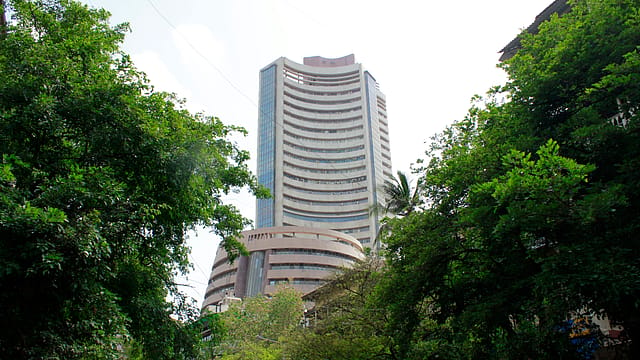Monday blues for equity markets
ADVERTISEMENT

In the last few days speculation was rife on what was in store for Jammu and Kashmir. Key triggers for it was the deployment of troops and the restriction on the movement of local leaders in the state torn by decades of extremism.
So, on Monday, investors, with an eye on benchmark indices, were eagerly waiting for the outcome of the Union cabinet meeting called by Prime Minister Narendra Modi. Early morning trade did not begin well. For markets, shaken by weak corporate earnings and global trade tensions, the first whiff of trouble was Chinese Yuan tumbling more than 1% to hit an 11-year low. This added some fuel to fire as Asian currencies saw a sell-off, where the Indian rupee was no exception as the exchange rate fell over 90 paise to breach the ₹70-mark to touch ₹70.66 a dollar.
Later, the outcome of the cabinet meeting on Jammu and Kashmir pushed down the S&P BSE Sensex and Nifty 50 by more than 701 (-1.89%) and 214 points (-1.95%) respectively to touch the day’s low of 36,416.79 and 10,782.6, compared to August 2’s close of 37,118.22 and 10,997.36 points.
The S&P BSE MidCap and SmallCap indices also joined the falling spree. The former fell more than 291 points (-2.15%) and the latter, 323 points (-2.59%) from the previous day’s close of 13,546.92 and 12,496.35 points respectively. During the day, the MidCap and SmallCap indices registered new 52-week lows of 13,255.68 and 12,173.14.
January 2026
Netflix, which has been in India for a decade, has successfully struck a balance between high-class premium content and pricing that attracts a range of customers. Find out how the U.S. streaming giant evolved in India, plus an exclusive interview with CEO Ted Sarandos. Also read about the Best Investments for 2026, and how rising growth and easing inflation will come in handy for finance minister Nirmala Sitharaman as she prepares Budget 2026.
After knee-jerk reactions to Union home minister Amit Shah moving a resolution to abrogate most of the provisions under Article 370, and a separate bill to reorganise the state, markets began to stabilise as the 30-stock Sensex pared losses to close the trading day at 36,699.84—down by 418.38 (-1.13%), while the 50-stock Nifty closed 134.75 (-1.235) lower at 10,862.6 points.
While the markets have been on a downslide, some market experts believe that the Nifty 50 can see a meaningful bounce back of 5% to 7%. “For now, the markets seem to have discounted the worst on the fundamental front,” says Dharmesh Kant, head of retail research at Mumbai headquartered IndiaNivesh Securities. “The geopolitical developments involving the scrapping of Sec 370 and Article 35A with reference to Jammu and Kashmir and Ladakh are likely to help improve sentiment and will help restore sanity in the markets sooner than later,” Kant adds.
In Kant’s view, mid and small caps are currently trading at historically low valuations and that offers a good opportunity for the markets to bounce back. And that is likely to be backed by decisions aimed towards stimulating the economy through a dovish and accommodative approach by the monetary policy committee. Plus, there is little to be surprised if the surcharge on super-rich is rolled back for foreign portfolio investors (FPIs). “All this is further complimented by a fairly decent monsoon shaping up throughout the country,” says Kant. “A meaningful bounce back of 5% to 7% on the Nifty therefore seems to be a strong possibility,” he adds.
But that does not take the markets away from the current reality: all-round volatility. “We expect volatility to remain high in the near term and maintain our cautious stance on Indian markets,” says Ajit Mishra, vice president-research at Religare Broking. “Ongoing turmoil in Kashmir may induce volatility in the markets,” Mishra cautions. “On the global front, escalating trade tensions between the U.S. and China will keep market participants on edge and cause volatility in oil prices as well as currency,” he adds.
However, markets expect some relief from the monetary policy committee meeting on August 7. Given the comforting inflation data and declining growth, expectations are rife for a fourth consecutive rate cut of 25 basis points. “However, the commentary on growth and inflation would be a more important factor in deciding the course of markets,” Mishra opines.
Word about finance ministry officials planning to hold meetings with stakeholders from various sectors of the economy is another source of hope. “(This) could raise some hopes of an early action to tackle the current situation in the markets,” says Deepak Jasani, head-retail research, HDFC Securities.
While volatility rules the market, one needs to look out for opportunities to cherry-pick in the midcap and smallcap spaces, as the respective indices on BSE are down by 21.39% and 29.13% from their 52-week highs registered on September 3 last year. The broader Sensex and Nifty 50 are trading 8.96% and 10.25% lower than their respective 52-week highs.
